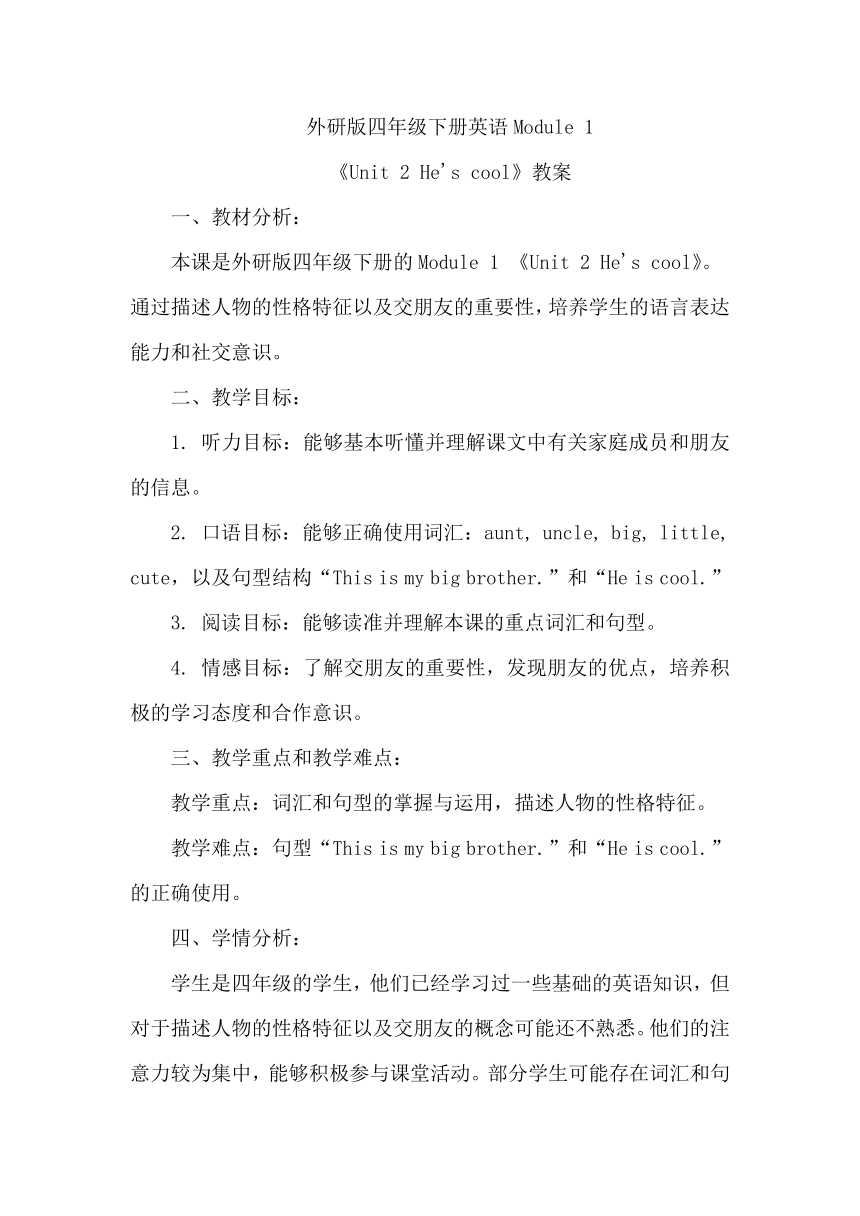
外研版四年级下册英语Module 1 《Unit 2 He's cool》教案 一、教材分析: 本课是外研版四年级下册的Module 1 《Unit 2 He's cool》。通过描述人物的性格特征以及交朋友的重要性,培养学生的语言表达能力和社交意识。 二、教学目标: 1. 听力目标:能够基本听懂并理解课文中有关家庭成员和朋友的信息。 2. 口语目标:能够正确使用词汇:aunt, uncle, big, little, cute,以及句型结构“This is my big brother.”和“He is cool.” 3. 阅读目标:能够读准并理解本课的重点词汇和句型。 4. 情感目标:了解交朋友的重要性,发现朋友的优点,培养积极的学习态度和合作意识。 三、教学重点和教学难点: 教学重点:词汇和句型的掌握与运用,描述人物的性格特征。 教学难点:句型“This is my big brother.”和“He is cool.”的正确使用。 四、学情分析: 学生是四年级的学生,他们已经学习过一些基础的英语知识,但对于描述人物的性格特征以及交朋友的概念可能还不熟悉。他们的注意力较为集中,能够积极参与课堂活动。部分学生可能存在词汇和句型掌握不牢固的情况,需要通过多次练习巩固。 五、教学过程: Step 1: Warm-up 1. Begin the class by greeting the students and asking them how their families and friends are doing. Encourage them to share any interesting or exciting updates. 2. Show a series of pictures of different family members and friends on a slideshow or on printed cards. Point to each picture and ask the students to name the person in English. For example, show a picture of a man and ask, "Who is this " Wait for the students to respond with "father" or "dad." Step 2: Presentation 1. Introduce the new vocabulary words: aunt, uncle, big, little, and cute. Write the words on the board or display them on flashcards. 2. Show visual aids or real objects that represent each vocabulary word. For example, show a picture of an aunt and say, "This is an aunt. She is your father's or mother's sister." 3. Engage the students by asking questions and providing examples. For instance, ask, "Do you have any aunts or uncles Can you describe them using the words big, little, or cute " 4. Teach the sentence structures: "This is my big brother" and "He is cool." Write these sentences on the board and explain their meanings. Provide examples by describing a family member or friend using these sentence structures. For instance, "This is my big brother. He is tall and funny." Step 3: Practice 1. Play an audio recording or read aloud a dialogue that describes the characteristics of a family member or friend. Pause after each sentence and have the students repeat it to practice pronunciation and intonation. 2. Divide the class into pairs and have them take turns describing their own family members or friends using the target vocabulary and sentence structures. Encourage them to be creative and provide detailed descriptions. 3. Circulate among the students, providing guidance and support as needed. Listen to their conversations and offer suggestions for improvement. 4. Conduct group activities where students can practice describing different people's characteristics. For example, ask them to work in groups and create a poster with pictures and descr ... ...
~~ 您好,已阅读到文档的结尾了 ~~